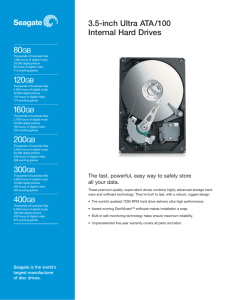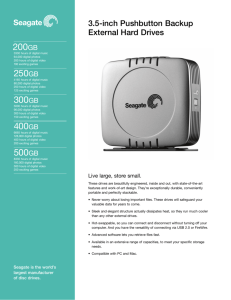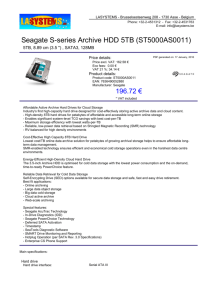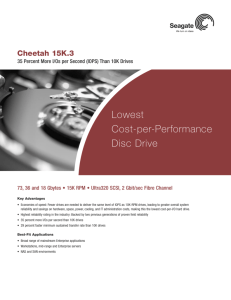The Hard Drive
advertisement
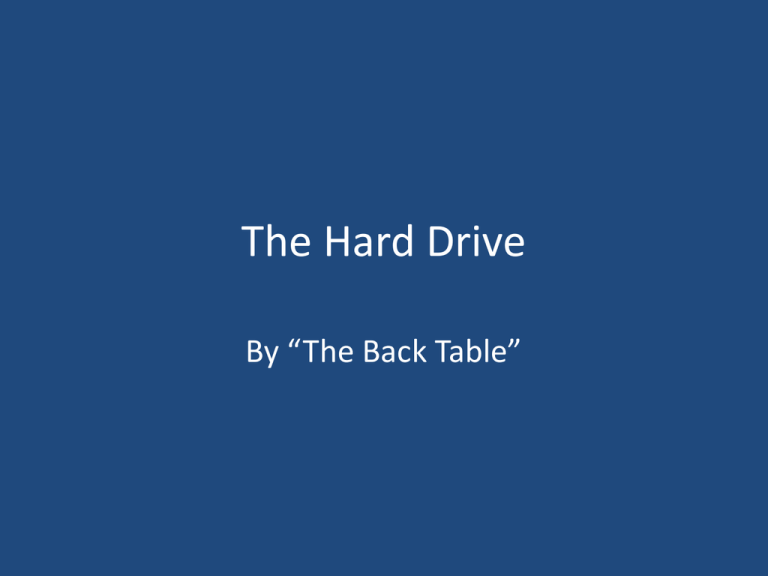
The Hard Drive By “The Back Table” Definition • Hard drive - a non-volatile storage (computer memory that can retain stored information even when not powered) device which stores digitally encoded data on rapidly rotating platters with magnetic surfaces Internal hard drive History • The first computer to include a hard drive was invented by IBM in 1956 • RAMAC • Had fifty 24-inch platters, with a total capacity for storing five million characters and an areal density of 2000 bits per square inch. • The data transfer rate of this first drive was 8800 bytes per second (2008 typical rate was 70 megabytes per second) RAMAC History • 1980 saw the launch of the world's first gigabyte-capacity disk drive, the IBM 3380, which was the size of a refrigerator, weighed 550 pounds and had a price tag of US$40 000. • In 1991 the 2.5-inch hard drive was introduced with 100MB capacity. • As of April 2009, the largest hard drive could store up to 2 TB How It Works • The basic parts of a hard drive are the platters, spindle and spindles motors, the read and write heads and the head actuators. • Platters are nothing but the glass or ceramic disk present inside the drive where all the data is stored magnetically. • Data transfers from the read/write heads to the magnetic layers of the platters, and it is then stored on the tiny domains of the positive and negative magnetization on both the sides of the platters. Types • Internal – two types of connections – IDE – Integrated Drive Electronics – SATA– Serial Advanced Technology Attachment • Faster and more efficient data transfer • Smaller (7 pins versus 40 pins) Types • External – – – – connected through USB or firewire Portable Usually has an external power source allows the user to back up or store important information separate from the main internal hard drive, which could become compromised by online or offline activities. – Sensitive documents, large music files, DVD images, movies, disk images, and even a backup of the contents of your main internal hard drive, can all be kept securely and safely on an external hard drive. When you are online, you can even leave the external drive turned off. Size, Capacity, and Speed • Desktop – 3.5” – 250 GB to 1TB – 7,200 – 15,000 rpm • Laptop – 2.5” – Typically 80 GB to 200GB – 5,400 – 7,200 rpm Life Expectancy • Depends on how often they are used • 2-5 years for a computer used on a regular basis • Most should last until outdated Maintenance • A hard drive needs to be defragmented. • Defragment means to organize and resort your files so that they can be found more quickly • To access click Start > Programs > Accessories > System Tools • Typically needs to be defragmented about once a month. Size, Options, Cost • Newegg.com – Western Digital External 1TB - $119.99 – Seagate External 1TB - $109.99 – Seagate Internal 1TB - $99.99 – Seagate Internal 500GB - $59.99 – Samsung Internal 500GB - $49.99 Size, Options, Cost • www.bestbuy.com – Maxtor External 1TB - $199.99 – Seagate External 500GB - $84.99 – Seagate External 1.5TB - $149.99 Size, Options, Cost • www.techbargins.com – Maxtor External 1TB - $99.99 – Seagate Internal 1.5TB - $125.99 – Seagate Internal 320GB - $72.99 Future • Eventually, manufacturers will combine heat-assisted and patterned media to produce drives that will be capable of storing 50 to 100 terabits of data per square inch. That's 280 to 560 times more dense than the 178.8 gigabit-per-square-inch drive coming from Toshiba later this year. (A square inch of 100-terabit material could hold as much data as 12,500 pickup trucks filled with books.) • Flash memory makers assert that their chips will start to displace drives in notebooks over the coming years. Why Flash? • Fast start-up, since you don’t have to wait for the disc platters to spin up • Much faster access time • Much faster boot times and application load times • Longer life span. While drive crashes are not a risk, the memory itself does have a life span. It is said that a typical flash drive will have about a 10-year life span. Technically, the technology in use in today’s hard drives has a long life span (the actual data), however, because of the mechanical nature of the drives, actual life span is much less. • No mechanical parts means less power, less heat, and NO NOISE. • Speed consistency. Normal hard drives usually slow down as they fill up, whereas flash drives can maintain constant speed even if at peak capacity. Thanks for watching!
